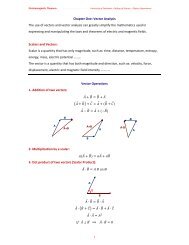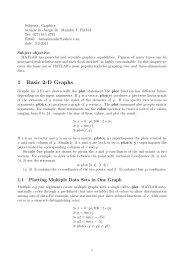Econ. Lec. No. 7 and 8 Minerogenic zonation in Iraq - University of ...
Econ. Lec. No. 7 and 8 Minerogenic zonation in Iraq - University of ...
Econ. Lec. No. 7 and 8 Minerogenic zonation in Iraq - University of ...
You also want an ePaper? Increase the reach of your titles
YUMPU automatically turns print PDFs into web optimized ePapers that Google loves.
<strong>Econ</strong>. <strong>Lec</strong>. <strong>No</strong>. 7 <strong>and</strong> 8<br />
<strong>M<strong>in</strong>erogenic</strong> <strong>zonation</strong> <strong>in</strong> <strong>Iraq</strong><br />
Ma<strong>in</strong> objective:<br />
A concept frequently referred to <strong>in</strong> the pages that follow is dist<strong>in</strong>ction<br />
between ore deposits type <strong>in</strong> <strong>Iraq</strong> <strong>and</strong> especially those that are distribute<br />
through north <strong>and</strong> northern part <strong>of</strong> Kurdistan. This subject emphasize<br />
on the ma<strong>in</strong> localities <strong>of</strong> metallic ore deposits <strong>in</strong> Kurdistan, economic<br />
important <strong>of</strong> the ore <strong>and</strong> give an idea about the m<strong>in</strong>eralogy <strong>of</strong> the ore<br />
<strong>and</strong> associated gangue m<strong>in</strong>erals.
Topics<br />
<strong>M<strong>in</strong>erogenic</strong> Zonation <strong>in</strong> <strong>Iraq</strong><br />
Distribution <strong>of</strong> the ma<strong>in</strong> ore types <strong>in</strong> <strong>Iraq</strong><br />
Metallic m<strong>in</strong>eral deposits <strong>in</strong> the suture zone<br />
(Kurdistan Region)<br />
Ora Thrust Zone metallic m<strong>in</strong>eral deposits<br />
M<strong>in</strong>eralization <strong>in</strong> the Zagrose Suture zone.
<strong>M<strong>in</strong>erogenic</strong> Zonation <strong>in</strong> <strong>Iraq</strong>:<br />
The M<strong>in</strong>eral <strong>and</strong> <strong>in</strong>dustrial rock potential was summarized <strong>in</strong> a map published<br />
by GEOSURV at 1: 1,000000 scale (AL- Bassam, et.al., 1987).<br />
<strong>Iraq</strong> was divided <strong>in</strong>to m<strong>in</strong>erogenic prov<strong>in</strong>ces, zone <strong>and</strong> districts accord<strong>in</strong>g to<br />
the type <strong>and</strong> orig<strong>in</strong> <strong>of</strong> the dom<strong>in</strong>ant m<strong>in</strong>eral commodity available at the<br />
surface or near-surface.<br />
The surface <strong>and</strong> near surface geology <strong>and</strong> tectonic subdivision were used to<br />
def<strong>in</strong>e genetic subdivisions.<br />
They comprise,<br />
A- <strong>No</strong>n-metallic deposits<br />
1- Mar<strong>in</strong>e sedimentary deposits<br />
2- Mar<strong>in</strong>e evaporate<br />
3- Cont<strong>in</strong>ental evaporate<br />
4- Fluvial deposits<br />
5- Aeolian deposits<br />
6- Laterites<br />
7- Biogenic deposits<br />
B- Metallic m<strong>in</strong>eralization<br />
1- Low temperature hydrothermal ve<strong>in</strong> <strong>and</strong> strata-bound deposits.<br />
2- Placer <strong>and</strong> secondary deposits<br />
3- Magmatic deposits<br />
4- Hydrothermal ve<strong>in</strong> <strong>and</strong> strata-bound (regionally metamorphosed ) deposits,<br />
5- Volcanosedimentary deposits
Fig.1
Table 1 Distribution <strong>of</strong> the ma<strong>in</strong> ore types <strong>in</strong> <strong>Iraq</strong><br />
Formation<br />
Gaara<br />
Triassic unit with<br />
Q<strong>and</strong>il series<br />
Mullusa<br />
Hussa<strong>in</strong>iat<br />
Amij<br />
Qulqula<br />
Age<br />
Permian -Carboniferous<br />
Triassic<br />
Upper Triassic<br />
Middle Jurassic<br />
Middle Jurassic<br />
L.Jurassic-Cretaceous<br />
Early Cretaceous<br />
Cretaceous<br />
Kaol<strong>in</strong>, Silica s<strong>and</strong>, Ironstone<br />
Pb,Zn, Pyrite, Barite<br />
Dolomite<br />
Ore type<br />
Kaol<strong>in</strong>, Ironstone<br />
Heavy m<strong>in</strong>erals (Zr,Rutile), S<strong>and</strong>,<br />
Fe ñ Mn Deposits<br />
Karst fill deposits, Bauxite,<br />
Kaol<strong>in</strong>ite<br />
Basic & ultra basic (Ni,Cr,Cu)
Digma<br />
Aqra-Bakhma<br />
Akashat<br />
Walash Series<br />
Ratga<br />
Damam<br />
Euphrates<br />
Fatha<br />
Injana<br />
Dibdiba<br />
Upper Cretaceous<br />
Upper Cretaceous<br />
Paleocene<br />
Paleocene<br />
Eocene<br />
Eocene<br />
Early Miocene<br />
Middle Miocene<br />
Late Miocene<br />
Pliocene<br />
Quaternary<br />
Phosphorite, Montimorllonite,<br />
Palygorskite<br />
Pb,Zn, Ba deposits<br />
Phosphorite ,clays, Porcalenite<br />
Cr-Ni deposits<br />
Phosphorite,Limestone<br />
Limestone<br />
Limestone , Dolostone, Uranium<br />
Gypsum, Rack salt, native Sulfur<br />
Palygorskite,Celestite<br />
S<strong>and</strong>, Celestite,Feldspars<br />
Clay for cement, clay for bricks,gravel,<br />
s<strong>and</strong>, Cont<strong>in</strong>ental salt deposits(<br />
Glauborite)
Metallic m<strong>in</strong>eral deposits <strong>in</strong> the suture zone (Kurdistan Region):<br />
Ora Thrust Zone metallic m<strong>in</strong>eral deposits:<br />
The <strong>No</strong>rthern Thrust Zone conta<strong>in</strong>s base metal deposits with barite,<br />
pyrite m<strong>in</strong>eralization, rare copper <strong>and</strong> some siderite ve<strong>in</strong>. Base metal<br />
occurrences <strong>in</strong> Ora Thrust Zone occur <strong>in</strong> two districts,<br />
1- The western district NE <strong>of</strong> Zakho<br />
Includes seven occurrences <strong>of</strong> Lead <strong>and</strong> Z<strong>in</strong>c m<strong>in</strong>eralization<br />
accompanied by barite. The most important <strong>of</strong> these is:<br />
Berzanik deposits which is restricted to a fault zone <strong>of</strong> NE-SW strike <strong>in</strong><br />
the Upper Permian Chia Zairi Formation Limestone <strong>and</strong> dolomites.<br />
The total length <strong>of</strong> the m<strong>in</strong>eralized zone is about 1200 m associated<br />
with there outcrops <strong>of</strong> gossans with barite Figs.1,2, <strong>and</strong> 4,5,6, <strong>and</strong> 7<br />
The m<strong>in</strong>eralization consists <strong>of</strong> barite, limonite, galena, sphalerite,<br />
simsthonite, calcite siderite <strong>and</strong> ankerite.<br />
Similar outcrops <strong>of</strong> barite ve<strong>in</strong> <strong>and</strong> gossans with Pb-Zn were also found<br />
near Alansh, Patruma-Massis Banik, Shiranish Islam, Lefan <strong>and</strong> Bosol.
2 - Eastern district to the N <strong>of</strong> Amadia<br />
They represent hydrothermal ve<strong>in</strong> m<strong>in</strong>eralization <strong>and</strong> described by<br />
occurrence <strong>of</strong> Cu-Pb about 6 km W <strong>of</strong> Ora village. It comprises a ve<strong>in</strong><br />
strik<strong>in</strong>g NW-SE about 1 m thick from which malachite, azurite,<br />
chalcocite, <strong>and</strong> possibly even galena were obta<strong>in</strong>ed. Other<br />
occurrences <strong>in</strong>clude Gire Zivi (Silver Hill) <strong>and</strong> Skefta Totaye.These<br />
deposits are located near the contact <strong>of</strong> Chia Zairi Limestone <strong>and</strong><br />
Mirga Mir shales.They consist <strong>of</strong> tectonic breccia <strong>of</strong> limestone<br />
fragments cemented by quartz, barite ve<strong>in</strong>s <strong>and</strong> pockets sta<strong>in</strong>ed with<br />
malachite <strong>and</strong> azurite are up <strong>of</strong> 0.5 m thick also altered limestone with<br />
ve<strong>in</strong>lets <strong>of</strong> barite <strong>and</strong> fluorite was found close to the outcrops.<br />
Fluorite ve<strong>in</strong>lets up to 1.5 cm thick comprised a massive, medium<br />
gra<strong>in</strong>ed, light violet to light green fluorite, <strong>and</strong> represent the only<br />
occurrences <strong>of</strong> fluorite <strong>in</strong> <strong>Iraq</strong>. Pebbles <strong>and</strong> fragments <strong>of</strong> galena <strong>in</strong><br />
scree were found near Bevavi.
Fig. 2 Metallic m<strong>in</strong>eral occurrences <strong>of</strong> <strong>No</strong>rthern Thrust Zone
The largest known deposit <strong>of</strong> base metal <strong>in</strong> Ora Thrust Zone is <strong>in</strong><br />
Serguza about 17 km NW <strong>of</strong> Amadia, (Fig.2 ) described by abundant<br />
hematite breccias consist<strong>in</strong>g <strong>of</strong> angular fragments <strong>of</strong> hematite enclosed<br />
<strong>in</strong> ferrug<strong>in</strong>ous limestone <strong>of</strong> the Upper Cretaceous Had<strong>in</strong>a Formation.<br />
Some gossans <strong>of</strong> unknown orig<strong>in</strong> were reported from localities at<br />
Moi, Kani Mase, Benavi , Serau, <strong>No</strong>ola these gossans have relatively<br />
simple m<strong>in</strong>eralogy, <strong>and</strong> dolomitic host rocks <strong>of</strong> Permian ñ Triassic age.
M<strong>in</strong>eralization <strong>in</strong> the Zagrose Suture zone.<br />
Three types <strong>of</strong> Iron m<strong>in</strong>eralization are found <strong>in</strong> the Zagrose suture are:<br />
1- Contact metasomatic or skarn deposits.<br />
2- Magmatic segregation deposits.<br />
3- Hydrothermal ve<strong>in</strong>s <strong>and</strong> lenses <strong>of</strong> siderite.<br />
The major iron occurrence <strong>of</strong> contact metasomatic character are<br />
concentrated near Penjween the largest one is Asnawa deposit, located<br />
about 3.5 km S,SW <strong>of</strong> penjween town (Fig.3 a) .<br />
Skarn type magnetite m<strong>in</strong>eralization was also described from Marapasta<br />
area <strong>in</strong> the Q<strong>and</strong>il range <strong>of</strong> Zagrose suture Zone, NE <strong>of</strong> Ranya (Fig.3 b)<br />
Magnetite occurs <strong>in</strong> small lenses <strong>in</strong> siliceous limestone <strong>and</strong> schist <strong>in</strong> the<br />
lower unit <strong>of</strong> penjween group accompanied by m<strong>in</strong>or pyrrhotite, pyrite,<br />
chalcopyrite <strong>and</strong> arsenopyrite.
1- Magmatic segregation deposits.<br />
Magmatic Iron ore occur as magmatic segregations associated with<br />
chromite or are related to serpent<strong>in</strong>ization <strong>of</strong> ultramafic bodies.<br />
Magnetite ñ chromite bodies are restricted to two ma<strong>in</strong> districts:<br />
A- Penjween <strong>and</strong>, B- Raw<strong>and</strong>uz.<br />
Numerous small ve<strong>in</strong>- like <strong>and</strong> irregular magnetite bodies accompanied<br />
by chromite occur <strong>in</strong> ultramafic rocks (serpent<strong>in</strong>ized peridotite) <strong>in</strong> the<br />
Penjween Massive occurs <strong>in</strong> three ma<strong>in</strong> localities<br />
1- Karigapla, 2- Buban 3- Kani Manga<br />
Similar iron m<strong>in</strong>eral deposits are associated with chromite <strong>in</strong> the<br />
Mawat Massif.
Massive Chromite occurs <strong>in</strong> serpent<strong>in</strong>ized peridotite near Kura Dawi<br />
village, placer chromite was reported from Kani Sard NE<br />
Sulaimani which probably derived from the Mawat Massif.<br />
Manganese ore are mostly restricted to the Qulqula Group <strong>and</strong> are<br />
exposed between Sulaimani <strong>and</strong> Penjween. Dome Mn occurrences<br />
were also reported NE <strong>of</strong> Ranya. In both two localities the Mn<br />
deposits associated with radiolarian chert suggest a deep oceanic<br />
orig<strong>in</strong> possibly related to manganese nodule formation<br />
Small ve<strong>in</strong> <strong>of</strong> Nickel m<strong>in</strong>eralization were found at n<strong>in</strong>e sites<br />
near the Bardi-Zard village <strong>in</strong> Darb<strong>and</strong> Rayat area.the m<strong>in</strong>eralogy <strong>of</strong><br />
this type ore deposits represents by<br />
Niccolite, rammeslsergite, arsenopyrite, pyrite carbonates<br />
<strong>and</strong> secondary annabergite <strong>and</strong> marcasite
Cupper ore <strong>in</strong> the Zagrose Suture Zone Occur <strong>in</strong> two form<br />
1- Dissem<strong>in</strong>ated m<strong>in</strong>eralization <strong>in</strong> ultramafic <strong>and</strong> mafic magmatic<br />
rocks <strong>and</strong><br />
2- Hydrothermal m<strong>in</strong>eralization <strong>in</strong> quartz ve<strong>in</strong> <strong>and</strong> most are not<br />
economic <strong>in</strong>terest.<br />
They are related to serpent<strong>in</strong>ized ultramafic rocks <strong>and</strong> gabbros <strong>of</strong> the<br />
Penjween, Mawat <strong>and</strong> Bulfat massifs <strong>and</strong> metavolcanite.<br />
The m<strong>in</strong>eralization consist <strong>of</strong><br />
Malachite, chalcocite, chrysocolla, limonite (replac<strong>in</strong>g pyrite) <strong>and</strong><br />
quartz. More than ten copper occurrences conta<strong>in</strong> malachite <strong>and</strong> Cubear<strong>in</strong>g<br />
pyrite were reported near Jira village east <strong>of</strong> Qalat Diza (Fig.3b).<br />
Hydrothermal Cu ore orig<strong>in</strong> were <strong>in</strong>vestigated near spidareh village <strong>in</strong><br />
the Pushtashan Valley <strong>of</strong> the Q<strong>and</strong>il Range, they comprise local ve<strong>in</strong><br />
<strong>and</strong> impregnation <strong>in</strong> tuffaceous phyllites <strong>and</strong> norite <strong>and</strong> quartz<br />
albitophyres
In Waraz area <strong>of</strong> Mawat Massif the Cu were <strong>in</strong>vestigated<br />
as copper associated with metabasalt (600 m thick) <strong>and</strong><br />
as lenses <strong>of</strong> malachite between gabbro or as dissem<strong>in</strong>ated<br />
chalcopyrite with<strong>in</strong> the volcanic basalt (Fig.3 b).
Fig.3 a- Distribution <strong>of</strong><br />
metallic m<strong>in</strong>eral <strong>and</strong><br />
occurrences <strong>in</strong> the S -<br />
part <strong>of</strong> Zagrose suture<br />
Zone (after Vanecek,<br />
1972)<br />
A
Fig.3 b Distribution<br />
<strong>of</strong> metallic m<strong>in</strong>eral<br />
<strong>and</strong> occurrences <strong>in</strong><br />
the N part <strong>of</strong><br />
Zagrose suture Zone<br />
(after Vanecek,<br />
1972)<br />
B
Fig. 4 M<strong>in</strong>eralization zone <strong>in</strong> Banik area N- thrust zone
Fig. 5 Ve<strong>in</strong> <strong>of</strong> barite <strong>in</strong> Aqra Formation Lfan areaN-thrust zone
Fig. 6 Coarse crystal <strong>of</strong> Galen associated with carbonate rocks <strong>in</strong> Lefan area N-<br />
Thrust Zone
Smithsonite<br />
Spalerite.<br />
Siderite<br />
Barite<br />
Fig. 7 Association <strong>of</strong> Barite-sphalerite-smithsonite-siderite <strong>in</strong> Lefan area-<br />
N-Thrust Zone
References:<br />
Al-bassam, K. <strong>and</strong> Akif, A. 1977 The ore m<strong>in</strong>eralogy <strong>of</strong> the Marabasta<br />
Lead-Z<strong>in</strong>c deposit <strong>No</strong>rtheastern <strong>Iraq</strong>, Jour. Of Geological Society <strong>of</strong><br />
<strong>Iraq</strong>, Vol. X, pp. 12-32.<br />
Awadh, S.M. 2006 M<strong>in</strong>eralogy, geochemistry <strong>and</strong> orig<strong>in</strong> <strong>of</strong> the Z<strong>in</strong>c-<br />
Lead-Barite deposits from selected areas from north OF Zakho,<br />
<strong>No</strong>rthern <strong>Iraq</strong>, Unpublished PhD. Thesis, UNIVERSITY OF<br />
BAGHDAD,182 p.<br />
Jassim, S.Z. <strong>and</strong> G<strong>of</strong>f, C. Geology <strong>of</strong> <strong>Iraq</strong>, 2006, Published by<br />
Dol<strong>in</strong>,Prague Moravian Museum, Brno, 341p.
Thank you for your attention<br />
<strong>and</strong><br />
Good Luck<br />
Instructor<br />
Dr. Tola A. Mirza<br />
Assistant Pr<strong>of</strong>essor<br />
tola.merza@univsul.net<br />
2010-2011

















